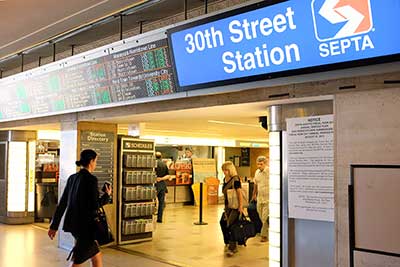

The Preferred Alternative included the adoption of enhanced service and precision operations concepts. These enhanced operating concepts represent national and international best practices, and are aimed at enhancing the attractiveness and convenience of train services, increasing the efficiency of operations, lowering the cost per capita of delivering rail service, and making the most efficient use of investments in new rail infrastructure, while providing flexibility for rail operators to deliver service that best meets the needs of the market in 2040. Examples are described below.
The representative Service Plan for the Preferred Alternative provided for regular schedules for all train services operating on the NEC. Trains would operate at regular intervals, rather than on the basis of demand, as is the case today. Services operated at regular 15-, 30-, or 60-minute intervals, with local stations generally receiving two to four trains per hour during peak periods and major stations often receiving more service.
The Preferred Alternative introduced Metropolitan service, a new service concept that upgrades the level of Intercity-Corridor service provided on the NEC, offers frequent service (2—4 trains per hour) to large and mid-size markets and key transfer locations, and stops at more stations than current Intercity service.
Regional rail run-through service, particularly applicable to Washington, D.C., and New York City, links branch lines from the different regional service operators and provides continuous revenue service on both sides of the metropolitan region through the Central Business District. It enables passengers to avoid transfers when traveling from one regional rail station to another through stations such as Penn Station New York and Washington Union Station. It also provides reduces dwell time at stations and reduces the number of train movements.
The Preferred Alternative provided through running opportunities at both Washington, D.C. (VRE and MARC trains) and New York City (MNRR/LIRR and NJ TRANSIT trains). Through operations not only would enhance connectivity for passengers and expand capacity, they make for more efficient use of trains and storage areas.
This includes the coordinated scheduling of Regional rail trains on systems that have multiple branch lines or multiple terminals, or where the outer ends of two Regional rail systems meet at a common station (defined as endpoints). This enhanced service concept provides for convenient passenger connections, extending the reach of the existing systems, substituting for costly extensions for one-seat-ride service, and providing a much more convenient transfer experience for rail travelers. The Preferred Alternative took advantage of opportunities for better connected Regional rail service at several locations on the NEC, effectively closing the gaps that now exist in Regional rail connectivity from one system to another. The Preferred Alternative also improved connectivity between main line and branch line services at multiple locations.
A pulse-hub is a special application of service coordination, where multiple trains converge on a single hub station concurrently or in close succession, dwell simultaneously for a period of time while passengers transfer from one service to another, and then depart toward their various destinations. The representative Service Plan for the Preferred Alternative provided for pulse-hub operations at Philadelphia 30th Street Station and in New Haven, CT, where passengers would be able to transfer between a highly coordinated network of Intercity and Regional rail trains.
The information posted on this website includes hypertext links or pointers to information created and maintained by other public and/or private organizations. The FRA provides these links and pointers solely for information and convenience. When users select a link to an outside website, they are leaving the NEC FUTURE website and are subject to the privacy and security policies of the owners/sponsors of the outside website. The FRA does not control or guarantee the accuracy, relevance, timeliness or completeness of information contained on a linked website, or endorse the organizations sponsoring linked websites, the views they express, or the products/services they offer. The FRA cannot authorize the use of copyrighted materials contained in linked websites and is not responsible for transmissions users receive from linked websites.